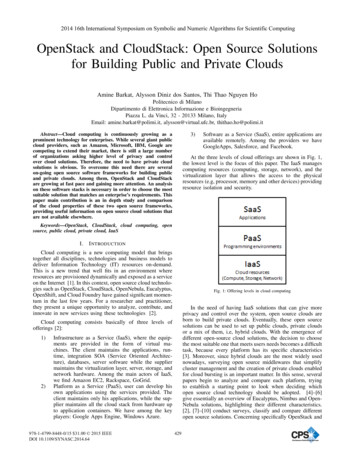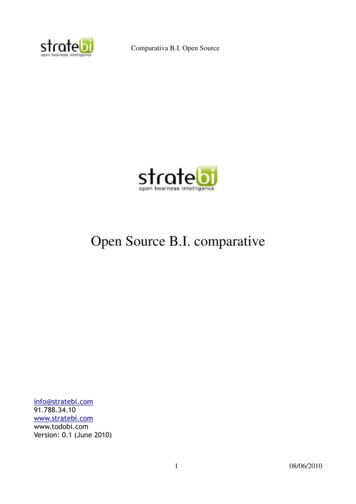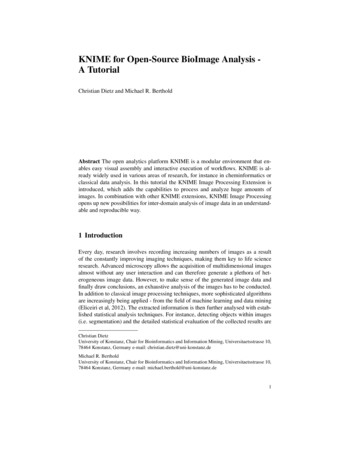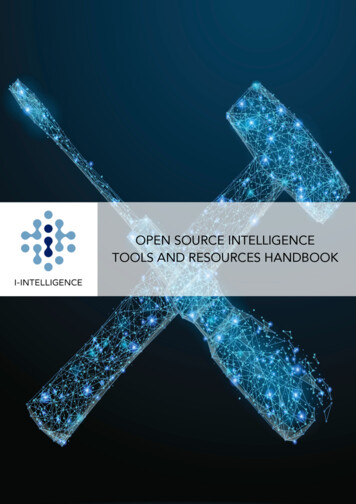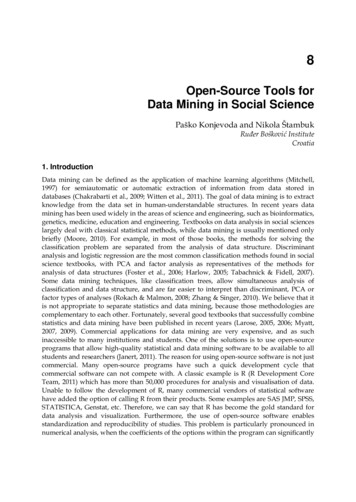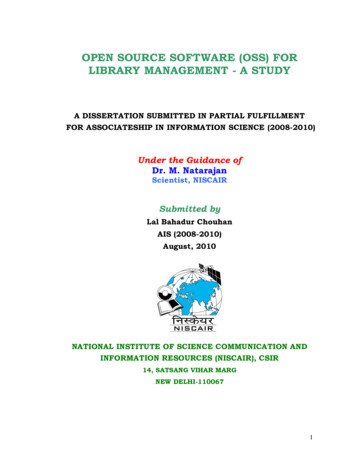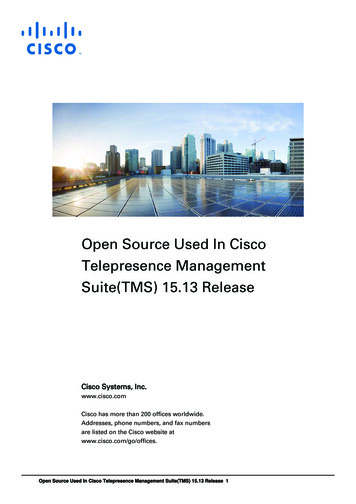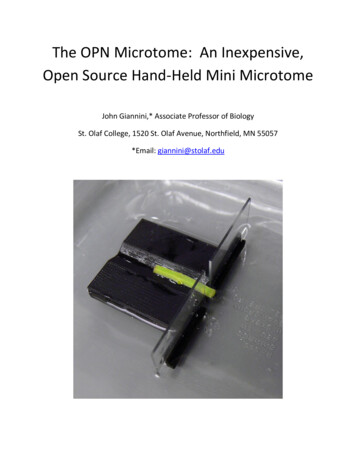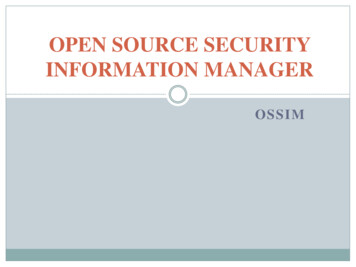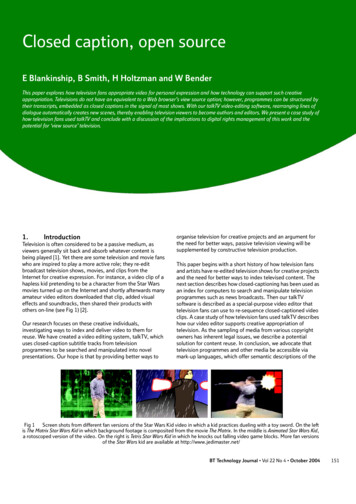
Transcription
Closed caption, open sourceE Blankinship, B Smith, H Holtzman and W BenderThis paper explores how television fans appropriate video for personal expression and how technology can support such creativeappropriation. Televisions do not have an equivalent to a Web browser’s view source option; however, programmes can be structured bytheir transcripts, embedded as closed captions in the signal of most shows. With our talkTV video-editing software, rearranging lines ofdialogue automatically creates new scenes, thereby enabling television viewers to become authors and editors. We present a case study ofhow television fans used talkTV and conclude with a discussion of the implications to digital rights management of this work and thepotential for ‘view source’ television.1.IntroductionTelevision is often considered to be a passive medium, asviewers generally sit back and absorb whatever content isbeing played [1]. Yet there are some television and movie fanswho are inspired to play a more active role; they re-editbroadcast television shows, movies, and clips from theInternet for creative expression. For instance, a video clip of ahapless kid pretending to be a character from the Star Warsmovies turned up on the Internet and shortly afterwards manyamateur video editors downloaded that clip, added visualeffects and soundtracks, then shared their products withothers on-line (see Fig 1) [2].Our research focuses on these creative individuals,investigating ways to index and deliver video to them forreuse. We have created a video editing system, talkTV, whichuses closed-caption subtitle tracks from televisionprogrammes to be searched and manipulated into novelpresentations. Our hope is that by providing better ways toorganise television for creative projects and an argument forthe need for better ways, passive television viewing will besupplemented by constructive television production.This paper begins with a short history of how television fansand artists have re-edited television shows for creative projectsand the need for better ways to index televised content. Thenext section describes how closed-captioning has been used asan index for computers to search and manipulate televisionprogrammes such as news broadcasts. Then our talkTVsoftware is described as a special-purpose video editor thattelevision fans can use to re-sequence closed-captioned videoclips. A case study of how television fans used talkTV describeshow our video editor supports creative appropriation oftelevision. As the sampling of media from various copyrightowners has inherent legal issues, we describe a potentialsolution for content reuse. In conclusion, we advocate thattelevision programmes and other media be accessible viamark-up languages, which offer semantic descriptions of theFig 1Screen shots from different fan versions of the Star Wars Kid video in which a kid practices dueling with a toy sword. On the leftis The Matrix Star Wars Kid in which background footage is composited from the movie The Matrix. In the middle is Animated Star Wars Kid,a rotoscoped version of the video. On the right is Tetris Star Wars Kid in which he knocks out falling video game blocks. More fan versionsof the Star Wars kid are available at http://www.jedimaster.net/BT Technology Journal Vol 22 No 4 October 2004151
Closed caption, open sourcecontent, so that their presentation can be more easilymanipulated for creative projects.instructions for a recipe being completed by Dr Ruth, sextherapist.2.Although the comic dialogue in this storyboard is scripted, itdemonstrates how dialogue can be used for creativerepurposing.Creative appropriation of televisionIn the late 1970s, television fans started re-editing televisionshows for personal expression. By connecting the video outputfrom one consumer VCR to the video input on another VCR,these fans dubbed cued video clips. In this way, television fansassembled their own montages, often set to popular music.Screenings of fan vids took place at science-fictionconventions, where other fans learned the procedure, thusproliferating the art of fan viding, which remains populartoday. A well-crafted fan vid juxtaposes video clips withrelevant song lyrics; thereby creating a novel interpretation ofthe television show’s canon. For example, a well produced StarTrek fan vid juxtaposes video clips of Kirk and Spock gazinginto the distance cued to the lyrics of a romantic ballad,thereby suggesting romance between these characters [3].These vids assume an audience not only familiar with the showand its characters, but also with meanings and vocabulary ofthe fan culture that produces them. For example, the fangenre of slash fiction (in written works) had been establishedfor a decade before vids were produced.To find desired video clips, fans must have an exhaustiveknowledge of a television show. To help find video clips nearmemorable events, some fans produce ‘clip notes’, which arelistings of approximate times for memorable events in certainepisodes. Fan vidders are not the only ones indexing contentfor creative repurposing; popular artists are also combingthrough hours of television:Working with a computer database, [artists Jennifer andKevin McCoy] have sliced and diced several emblematictelevision shows into their component parts. A result ofthis archaeology of entertainment is the digitalequivalent of thousands of carefully labelled pot shards.The McCoys sorted and categorised scenes from KungFu and postwar Looney Tunes on DVDs, which expose theviewer to endless variations on blocked punches orexplosions. They dissected an episode from Eight IsEnough into 448 shots, also on DVDs, arranged in a bigcolour-coordinated grid on the wall. They splicedtogether a disjunctive show-within-a-show using all theaction shown on the big flight-deck screen of theStarship Enterprise from the first season of Star Trek [4].For the McCoys, creating indices with which to disassembleand then reassemble television shows is creative interpretationand commentary on the shows’ content. Sophomorichumourists at MAD Magazine [5] have also repurposedtelevision to this effect, noting: ‘[television] programs are asboring as ever, so now [people] spend all of their time pushingthe button on the cable box to switch from station to station,which creates a strange kind of craziness we call. MAD’SCABLE TV ROULETTE.’MAD’s Roulette is a comic storyboard of frames grabbed fromvarious television programmes in which television hostscomplete each other’s sentences, such as Chef Julia Child’s152BT Technology Journal Vol 22 No 4 October 2004Dialogue is a useful index into video, as people tend toremember dialogue. In fact, people regularly appropriatetelevision dialogue when they cite familiar quotes in theirconversations. Quips such as ‘Live long and prosper’ (StarTrek), ‘D’oh!’ (The Simpsons), and ‘Wassup!’ (Budweisercommercial) convey a shared meaning between people.Appropriated television and movie quotes are also common ine-mail signature lines, often selected for a personal flourish.Another use of dialogue for conversational purposes, albeitprimarily prank calls, is via soundboard software, which playscelebrity sound bites at the push of a button. Soundboardcreators search through television shows for audio clips toembed in their soundboards, much like fan vidders search forvideo clips.in the late 1970s, televisionfans started re-editingtelevision shows for personalexpressionSearching through video for a specific clip is not an easy task,and consumer devices such as VCRs only offer rewinding,pausing, and fast forwarding as their main search features.Perpetuating television as a browse only medium, DVDsstructure their contents in the form of video chapters within amenu structure. Personal video recorders (PVRs) such as TiVoalso list recorded shows in menus. The next section of thispaper describes how closed-captioned dialogue has been usedas an alternative index into television.3.Alpha bits — indexing television withsubtitlesWith a pioneering spirit, and a bit of hacking, computerresearchers in the 1980s began to play with television signalsto see how they could be digitally manipulated. Closedcaptioning, used primarily to broadcast subtitles on thevertical blanking interval of a television signal, presented itselfas a useful index into televised data. Because of legislation [6],closed captions are broadcast with a wide and expandingvariety of programming.Searching through digitised text is less computationallyexpensive than searching through image data, and has theadditional benefit of being relatively easy to query. One earlyproject that used computational search of television wasNetwork Plus [7], which augmented televised news broadcastswith contextual information from the Associated Press newswire. Keywords extracted from the closed-caption data wereused to retrieve relevant information from external databases,such as the wire services, and this information was presentedas a synchronous overlay to the broadcast programme using
Closed caption, open sourcethe closed captioning as a time code. Another project, AutoCassette [8], parsed the closed captioning from evening newsbroadcasts to automatically segment news stories and createa table of contents of the broadcast. Titles for the news storieswere extracted from the first sentence following thenewscaster’s introduction.Despite closed captioning offering both a temporal anddescriptive index into televised content, most consumertelevision devices today have relegated closed captions to beused as a display-only mechanism. However, two consumerdevices use the closed captions to prevent the display ofsubtitled dialogue — Curse-Free TVTM and TVGuardianTMscan closed captions for profanity and both silencecorresponding offensive audio and present alternate subtitles.Some personal-computer video-capture cards also scan closedcaptions, and have bundled software to alert users when keywords are spotted or to create written transcripts (withouttime code). Consumer devices treat subtitles as just anothertrack, which can be turned on and off like video or audio,instead of using the information to organise televisioncontent.talkTV is a graphic editordesigned to assist televisionfans re-sequence televisiondialogueThe advent of the World Wide Web popularised a new way ofusing text to organise multimedia. Web pages are written astext files using hypertext markup language (HTML) tostructure their hyperlinks, graphical layout, and multimediacontent for a Web browser to display. Every Web browser sincethe original Mosaic browser has a ‘view source’ menu itemthat reveals these HTML source files, making it possible forpeople to copy and modify a Web page and use it as atemplate for their own page [9]. Television, a far moreubiquitous medium, does not have an equivalent optionallowing people to ‘look under the bonnet’.Could television shows be organised like Web pages so as tobe more easily modified? Closed captions can be saved as atext file that references and sequences many multimediasnippets of dialogue. Just as a Web page’s HTML code mayreference other files such as GIF and JPEG images, each line ofsubtitled dialogue references a snippet of audio and video.However, televisions do not use closed captions to structurethe display of television programmes in the same way that aWeb browser uses HTML. But if television shows wereorganised this way, reordering the sequence of the closedcaptions would create new videos. With this in mind, wecreated a video editor to treat closed captioning as if it were amarkup language to see how it would effect television fans’abilities to reuse television content in creative projects.4.From remote control to direct controlThis section of the paper describes how our talkTV softwareassists television fans with their re-editing of television shows.Television shows used for this research project were digitisedfrom broadcasts, VHS tapes, and DVDs into MPEG1 moviefiles of their video and audio content and XML text files oftheir closed captions (see Fig 2). Digitised television shows areplaced into a folder where talkTV loads in their closedcaptioned transcript, which includes time code of when a lineof dialogue approximately begins and ends in the televisionshow. The talkTV editor segments television shows into smallclips of dialogue by marking in points at the beginning of aclosed caption and marking out points on stop characters inthe subtitles such as periods, question marks, and exclamationpoints. In this way, talkTV processing roughly parses thecontent at the boundaries where dialogue exchanges takeplace. ?xml version ’1.0’ encoding ’UTF-8’? — EPISODE mov ’101.mov’ — clip num ’0’ source line ’Space, the final frontier.’tc ’00:00:20.11’ tcout ’00:00:25.25’/ mods / /clip — clip num ’1’ source line ’These are the voyages of theStarship Enterprise.’tc ’00:00:25.25’ tcout ’00:00:29.20’ / mods / /clip — clip num ’2’ source line ’Its continuing mission.‘tc 00:00:29.21’ tcout ’00:00:31.20’/ mods / /clip Fig 2A sample of our XML representation of closed captiondata. Time code in points and out points are indicated by attribute elements such as ‘tcin ’ and ‘tcout ’ to mark the boundariesof dialogue exchanges. Adjustments to these times can be madethrough the talkTV application; any modifications are saved to the‘mods’ element so that the original time code is not lost.TalkTV is a graphic editor designed to assist television fans resequence television dialogue. Since talkTV uses closedcaptions in the form of text documents to organise televisioncontent, a text-only document editor could also be custombuilt wherein time-coded subtitle elements from variousclosed caption XML documents could be cut and pastedtogether to create new fan videos. However, talkTV was builtin the spirit of Web page editors such as NetscapeComposerTM, Microsoft FrontPageTM, and MacromediaDreamweaverTM, which assist in the modifying of HTML
how television fans used talkTV and conclude with a discussion of the implications to digital rights management of this work an d the potential for ‘view source’ television. 1. Introduction Television is often considered to be a passive medium, as viewers generally sit back and absorb whatever content is being played [1]. Yet there are some television and movie fans


